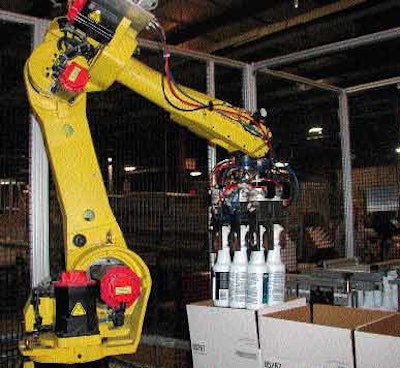A robotic cell that packs chemical containers into corrugated cases is eliminating repetitive manual operations at a US Chemical plant in Watertown, WI. The system, designed by Promatech, LLC (www.promatechgroup.com), was integrated with the plant’s existing filling, capping, case erecting, and conveying system. It incorporates a six-axis robot with a series of interchangeable grippers.
US Chemical, a JohnsonDiversey Company, is the nation’s largest supplier of privately-branded specialty cleaning chemicals, which are used by housekeeping and janitorial services at hospitals, hotels, colleges, and other institutions. The Watertown plant packages these products, including both liquid and powder formulas, in large plastic bottles ranging from spray bottles to quarts and gallon sizes.
Before the six-axis robotic cell was installed, containers were packed into cases manually, typically four or six to a case. As the volume and variety of products and containers increased, it became necessary to add a second shift and another operator. That’s when the robotic solution started to look pretty appealing.
“Increased speed wasn’t really a factor, but with the operation automated, we get some consistency, and we don’t have to worry about operator fatigue setting in,” says plant lead Robert Dourlain. The changeover was made without laying off any employees, he notes. “We were able to re-assign them to other areas where we needed extra labor and weren’t ready to automate.”
The robotic system, which was designed and developed by Promatech engineers, went into operation in February ’05. The robot itself is a six-axis M-16iB™ series, articulated-arm robot from Fanuc (www.fanucrobotics.com). It uses several different end-of-arm grippers, designed by Promatech, to handle various container sizes and configurations.
Parallel conveyors
In operation, filled containers and empty cases approach the robotic cell on parallel conveyors. Conveyors carry the containers from the filler and labeler and direct them onto two adjacent tracks as they enter the cell. Sick (www.sickusa.com) sensors on each side are set to detect when the product is in place on the track. When the WT4/-2P330 proximity/diffuse sensors show that the correct number of containers needed to fill a case is in position, the robot picks them up and loads them into the next case in line. The sensors then detect that no product is in position and allow the next batch of bottles to move ahead.
Also in place as a safety measure are Sick E1000SK1 safety key devices. To enter the cell, an operator must activate a request-to-enter button. The robot then pauses at the next convenient point so that operator can use a special key to open the gate.
US Chemical sent a group of people to Promotech for training before the system was accepted. Dourlain says, “They did a dry run, and that gave them some exposure on how the machine operated,” says Dourlain. “After it was in place, the operators had a good understanding of how to make it work here.”
“Increased speed wasn’t really a factor, but with the operation automated, we get some consistency, and we don’t have to worry about operator fatigue setting in.”
The system was easy to learn, adds Dourlain, even though the US Chemical operators had no prior experience with such automated equipment. Dourlain says that they have a maintenance person check the setup if they encounter any issues, but the operators continue to learn the skills needed to perform more of the setup and changeover between containers themselves. In addition, Promatech provides around-the-clock technical support when needed.
Operators use the Fanuc iPendant to program the robot and make adjustments in its operation. The color, Internet-ready teaching pendant is Microsoft Windows®-based and easy for the operators to use, Dourlain notes.
The line operates two shifts per day, five days a week. “In most cases,” Dourlain says, “we try to run different formulas that all use quart bottles, gallon bottles, or bottles with sprayers together to get a longer run time without changing the robot tooling.” He says it takes about 10 min to change an end-of-arm effector, but he expects to cut that in half through some planned modifications to the attachments.
—Pat Reynolds





























